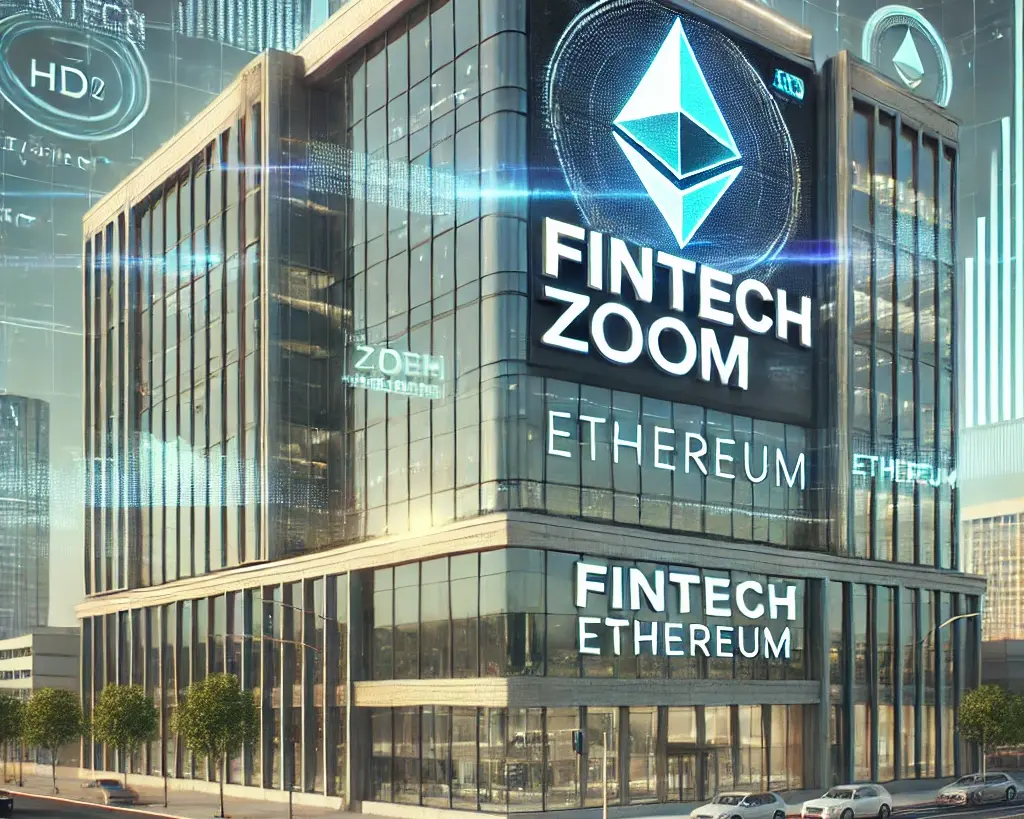Fintech Zoom Ethereum: The Future of Finance in the World of Smart Contracts, DeFi, and Beyond!
Ready to Zoom into the Future? 🚀
Imagine a world where you can send money across the globe in seconds, borrow without ever stepping into a bank, or even trade real estate on your smartphone—all without middlemen! Welcome to the magical realm of Fintech, where technology and finance come together to create the future of money. Now, throw in Ethereum, the superhero of blockchain, and you’ve got a game-changing combo that’s shaking up everything from banking to digital art.
Fintech Zoom Ethereum isn’t just a fancy phrase—it’s the rocket fuel powering decentralized finance (DeFi), smart contracts, and even those quirky digital artworks called NFTs. Whether you’re a finance whiz, crypto newbie, or just someone who loves keeping up with tech trends, this deep dive into Ethereum’s role in fintech is just what you need. So buckle up, because we’re about to explore how Fintech Zoom and Ethereum are joining forces to redefine the future of money, finance, and everything in between. 😎💰

1. Ethereum and Smart Contracts in Fintech
Ethereum has revolutionized the world of fintech by enabling the creation of smart contracts. These self-executing contracts, run on Ethereum’s blockchain, automate financial transactions, removing the need for intermediaries such as banks or legal institutions. ConsenSys and Metamask are leading platforms that allow developers to build decentralized applications (dApps) using smart contracts. Chainlink, through its decentralized oracles, connects real-world data to these contracts, enhancing their functionality.
Smart contracts are vital in modern Decentralized Finance (DeFi), a field where platforms like Uniswap, Aave, and Compound have become prominent. These contracts operate transparently, ensuring the reliability and security of every transaction. By eliminating third parties, smart contracts also reduce costs, a crucial aspect of financial technology.
Additionally, the Ethereum-based Ethereum Virtual Machine (EVM) supports multiple programming languages like Solidity, allowing developers to build more complex financial applications. dApps have flourished thanks to Ethereum’s smart contract functionality, including applications such as CryptoKitties and Axie Infinity, which offer innovative ways to engage with digital assets.
Ethereum vs. Traditional Finance
| Category | Ethereum-Based Fintech | Traditional Finance |
|---|---|---|
| Intermediaries | No intermediaries; transactions are automated via smart contracts | Requires banks, brokers, and middlemen for most financial services |
| Transaction Speed | Near-instant (depending on network congestion and Layer 2 solutions) | Can take hours to days, especially cross-border transactions |
| Fees | Gas fees, but often lower with Layer 2 solutions like Polygon | High fees for international transfers, broker fees, and hidden costs |
| Access | Open to anyone with an internet connection and a digital wallet | Requires bank accounts, financial institutions, often limited access |
| Security | Decentralized, secured by cryptographic algorithms and validators | Centralized, prone to single points of failure (e.g., hacking) |
| Transparency | Fully transparent, transactions are recorded on the blockchain | Limited transparency, often opaque with internal ledgers |
| Loan Approval | Automated via DeFi protocols (e.g., Aave, Compound) | Manual, lengthy processes with credit checks and legal hurdles |
| Ownership | Ownership through tokenization and NFTs | Ownership mostly in physical or traditional digital forms |
| Regulation | Lightly regulated, but evolving regulatory environment | Heavily regulated, particularly by governments and central banks |
| Privacy | Pseudonymous transactions, privacy via zk-SNARKs | Requires full personal details and ID checks |
| Innovation Pace | Rapid, driven by open-source communities and global collaboration | Slower, controlled by large institutions with regulatory constraints |
| Liquidity | Liquidity pools accessible to all; automated liquidity provision | Limited liquidity in certain markets; requires market makers |
2. Decentralized Finance (DeFi) on Ethereum
Ethereum serves as the backbone of the Decentralized Finance (DeFi) ecosystem, which is transforming traditional finance by decentralizing operations like lending, borrowing, and trading. Platforms such as Uniswap, Sushiswap, Aave, and Compound allow users to engage in peer-to-peer transactions through liquidity pools. These automated market makers (AMMs) facilitate asset swaps without intermediaries like banks or brokers.
Yield farming and liquidity mining are prominent DeFi strategies that have grown on Ethereum. Users provide liquidity to protocols like Balancer and Yearn Finance in exchange for governance tokens or additional rewards. Flash loans, a novel concept in the Ethereum ecosystem, have gained attention due to their ability to facilitate arbitrage and debt refinancing without collateral.

The decentralized nature of DeFi protocols empowers users to have full control over their assets, while the use of governance tokens, such as those offered by MakerDAO and Kyber Network, allows stakeholders to vote on protocol upgrades and treasury management. The proliferation of DeFi protocols on Ethereum underscores the network’s scalability and its role in shaping the future of financial technology.
3. Tokenization and NFTs
Ethereum’s blockchain has paved the way for tokenization, allowing real-world assets to be represented as digital tokens on the blockchain. These tokens come in various forms, such as ERC-20 fungible tokens or ERC-721 and ERC-1155 non-fungible tokens (NFTs). Platforms like OpenSea, Decentraland, and Enjin have leveraged Ethereum to build marketplaces where NFTs are bought, sold, and traded.
NFTs have surged in popularity, giving artists and creators a platform to tokenize and sell digital art, music, and collectibles. Projects like CryptoKitties and Axie Infinity were among the early movers in the NFT space, introducing gaming and digital ownership to a broader audience.
Through tokenization, Ethereum also allows for the digitization of physical assets, from real estate to art, providing liquidity and transparency in traditionally illiquid markets. The flexibility of Ethereum’s token standards, combined with smart contracts, ensures that assets can be securely exchanged and tracked across its decentralized network.
Live Ethereum Price on Fintech Zoom
4. Scalability and Layer 2 Solutions
One of the ongoing challenges for Ethereum has been scalability. As the network grew, high gas fees and slow transaction speeds became a concern, particularly during periods of congestion. Layer 2 solutions were developed to alleviate these issues. Platforms like Polygon, ZK-Rollups, Optimism, and Arbitrum offer solutions that process transactions off-chain, reducing gas prices and increasing throughput.
Plasma and Rollups are prominent technologies within the Ethereum ecosystem, enabling faster transaction processing by batching multiple transactions into a single one, thereby reducing the load on the Ethereum main chain. These scalability solutions are crucial for ensuring that Ethereum remains competitive and can handle the ever-increasing demand from dApps and DeFi protocols.
zkSync and StarkWare are also working on enhancing Ethereum’s scalability through zero-knowledge proofs and zk-SNARKs, which ensure the privacy and security of transactions without overburdening the network. With these advancements, Ethereum is set to handle a greater volume of transactions, meeting the needs of developers and users alike.
5. Staking, Liquidity, and Yield Optimization
With the launch of Ethereum 2.0, the network has transitioned from Proof of Work (PoW) to Proof of Stake (PoS), allowing users to earn rewards by staking their ETH. Platforms like Lido and Rocket Pool facilitate staking for users who wish to participate in network validation without the need for large capital requirements.
Yield farming and liquidity mining have become integral to the DeFi ecosystem on Ethereum. Platforms like Synthetix and Alpha Finance allow users to optimize yields by providing liquidity to decentralized exchanges (DEXs) or lending protocols. The ability to earn passive income through staking, liquidity provision, and yield farming has become a cornerstone of Ethereum-based DeFi protocols.

6. Stablecoins and Digital Currencies
Stablecoins such as USDC and Dai are essential to Ethereum’s DeFi ecosystem, offering users a way to participate in decentralized finance without exposure to the volatility of cryptocurrencies like ETH or Bitcoin. MakerDAO has played a pivotal role in creating Dai, a decentralized stablecoin pegged to the US Dollar, ensuring price stability through a system of collateralization and governance.
Ethereum is also poised to play a critical role in the development of Central Bank Digital Currencies (CBDCs), as governments explore blockchain-based solutions for the future of money. The flexibility and transparency of Ethereum’s network make it a strong candidate for building secure and efficient digital currencies.
7. Cross-Chain Interoperability
As blockchain ecosystems evolve, the need for cross-chain interoperability has become more apparent. Ethereum’s dominance in the blockchain space has prompted the development of bridges to other Layer 1 blockchains such as Solana, Avalanche, and Fantom. Projects like Polkadot and Cosmos aim to create seamless cross-chain bridges that enable the movement of assets and data across multiple blockchains.
These innovations allow Ethereum users to benefit from the speed and scalability of newer blockchains while maintaining access to the liquidity and security of the Ethereum network. Layer 2 solutions like Arbitrum and zkSync further enhance Ethereum’s interoperability by providing faster and cheaper transactions, making cross-chain integration smoother and more efficient.
8. Governance, Security, and DAOs
Decentralized Autonomous Organizations (DAOs) are a fundamental part of Ethereum’s ecosystem, allowing communities to manage protocols and funds through decentralized governance. Projects like MakerDAO, DeFi Pulse, and Balancer are governed by token holders who vote on key issues such as protocol upgrades and treasury management.
Security is paramount in the Ethereum ecosystem, with mechanisms like zk-SNARKs, zk-STARKs, and multi-signature wallets playing a crucial role in safeguarding assets and ensuring the privacy of transactions. These technologies enable users to engage with Ethereum confidently, knowing that their data and assets are protected by the network’s robust security features.
9. Ethereum Gas Fees and Optimization
Gas fees, or the costs associated with executing transactions on the Ethereum network, have been a major concern as the network scales. During periods of high demand, gas prices can surge, making transactions expensive. To combat this, developers are working on gas optimization strategies, which include reducing the complexity of transactions and leveraging Layer 2 solutions like Polygon and Optimism to handle more transactions off-chain.
Sidechains and off-chain transactions offer another way to reduce congestion on the Ethereum main chain, allowing users to conduct transactions more affordably while still benefiting from Ethereum’s security.
10. Future of Ethereum and Fintech
The future of Ethereum is incredibly promising, with ongoing upgrades such as sharding and new Ethereum Improvement Proposals (EIPs) aimed at improving the network’s scalability and efficiency. The rise of Web3, decentralized finance, and tokenization means that Ethereum will continue to play a pivotal role in fintech and blockchain innovation.

DeFi is set to expand further, with new protocols, governance models, and Layer 2 scaling solutions continuing to evolve. Ethereum’s ability to integrate with traditional finance through stablecoins, CBDCs, and tokenized assets ensures that it will remain a central player in the global financial ecosystem for years to come.
Conclusion
Ethereum: Redefining Finance with Blockchain Innovation 💡💰
Ethereum is reshaping the financial world, offering faster, more secure, and accessible solutions through DeFi, smart contracts, and NFTs. With its decentralized nature, anyone with internet access can participate, bypassing traditional barriers like banks and brokers. As Ethereum 2.0 and Layer 2 solutions improve scalability and reduce fees, the network continues to break new ground in finance.
The future of Fintech Zoom Ethereum is bright, as it drives innovation and opens new financial opportunities for everyone. Whether you’re a tech enthusiast or a finance newbie, you’re witnessing the beginning of a revolutionary financial era. 🌍🔗
FAQs
Glad you asked! Fintech Zoom Ethereum combines the best of fintech (financial technology) with Ethereum’s blockchain magic. It’s about using Ethereum to build better financial systems—whether it’s through faster payments, smarter contracts, or the wild world of DeFi. You should care because this duo is revolutionizing finance, giving people more control over their money, and creating opportunities like never before.
Think of smart contracts as super cool robots that run on code, but instead of flipping burgers, they execute financial agreements automatically! Built on Ethereum’s blockchain, these smart contracts remove the need for middlemen like banks or notaries. For example, if you borrow crypto from Aave, the repayment terms are written into a smart contract that only kicks in if certain conditions are met. No paperwork, no fuss—just pure automation. 🤖💼
You know how traffic jams can ruin your commute? The same thing happens on Ethereum when too many people try to use the network at once—gas fees go up, and transactions slow down. Layer 2 solutions like Polygon and Optimism are like building extra lanes on the highway. They handle transactions off-chain and then bundle them up and send them back to Ethereum’s main network. This way, everything runs smoother, faster, and cheaper! 🚗💨
DeFi (Decentralized Finance) is like the wild, wild west of finance—but in a good way. It’s an ecosystem where you can lend, borrow, and trade without banks or brokers. Platforms like Uniswap and Compound use liquidity pools (think of them as big pools of digital money) to make this possible. Yield farming is when you lend your crypto to earn rewards, and liquidity mining is when you provide liquidity and get paid in tokens for it. It’s like earning interest but way cooler. 🌾💸
Ethereum is the birthplace of NFTs (Non-Fungible Tokens), which are unique digital assets that represent ownership of things like art, music, or even virtual land. Platforms like OpenSea and Decentraland run on Ethereum and allow people to trade these assets. Meanwhile, tokenization is when real-world things (like a piece of art or real estate) are turned into digital tokens, so they can be traded just like stocks. It’s the future of ownership, and Ethereum’s leading the charge! 🎨🏠
